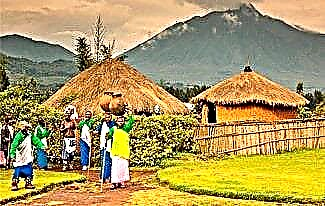Europeans became closely acquainted with koalas just 200 years ago, but during this time the cute eared creature managed not only the most famous Australian animal, eclipsing even the kangaroo, but also one of the most famous animals in the whole world. Everyone at least once, but was touched by this creature similar to a small bear cub with Cheburashka ears and a curious look.
In nature, koalas live only in Australia, and in zoos where they take root well, they are real stars not only because of their appearance, but also because of their dexterous and at the same time leisurely manner of moving. If there are koalas in the zoo, you can predict with a high degree of probability that the largest number of visitors, especially small ones, will be near their enclosure.
The appearance of koalas is deceiving: an angry animal in a rage is capable of attacking a person. Let's try to present a few more facts about these interesting animals.
1. Europeans first met koalas in 1798. One of the employees of the governor of the colony of New South Wales, John Price, reported that in the Blue Mountains (they are located in the far southeast of Australia) there lives a wombat-like animal, but it does not live in holes, but in trees. Four years later, the remains of a koala were discovered, and in July 1803, the Sydney Gazette published a description of a recently caught live specimen. It is surprising that koalas were not seen by members of the expedition of James Cook in 1770. Cook's expeditions were distinguished by special care, but apparently the solitary lifestyle of koalas prevented them from making the discovery.
2. Koalas are not bears, although they are very similar to them. It wasn't just the funny animal's appearance that contributed to the confusion. The first British settlers to Australia called the animal “Koala bear” - “Koala bear”. From former convicts and lower class British society in the late 18th century, it was difficult to expect ordinary literacy, let alone biological. Yes, and scientists reached an agreement on the koala's belonging to the class of marsupials only at the beginning of the next century. Of course, in everyday life, the combination "Koala bear" will be understandable to the absolute majority of people.
3. Koala is a very specific species in terms of biological classification. The closest relatives of the inhabitants of eucalyptus forests are wombats, but they are also very distant from the koala in terms of lifestyle and biologically.
4. Apart from nature reserves and zoos, koalas live only in Australia, and exclusively on its east coast and adjacent islands. On the example of the koala, it is clearly seen that the Australians are absolutely not taught by the negative experience of settling animal species on the continent. Having burnt themselves on ostriches, rabbits and even cats, in the twentieth century they enthusiastically began to settle koalas. nor did they not only restore the population of these marsupials in South Australia that had dwindled due to deforestation. The koal was relocated to Yanchepe National Park and a number of islands off the country's northeastern coast. The geography of settlement of koalas expanded to 1,000,000 km2, but we can only hope that the leisurely and good nature of koalas will help to avoid the next environmental problems. Although on the island of Kangaroo, where the koalas were forcibly brought, their number reached 30,000, which clearly exceeded the capacity of the food supply. The proposal to shoot 2/3 of the population was rejected as damaging the country's image.
5. The maximum body length of a koala is 85 cm, the maximum weight is 55 kg. Wool differs depending on the habitat - its color ranges from silver in the north to dark brown in the south. This gradation suggests that there are two different subspecies in the north and south, but this assumption has not yet been proven.

6. The diet of koalas is unique. Moreover, it consists exclusively of plant foods. Vegetation is slowly and poorly digested, forcing the animal to devote most of the day to nutrition. The diet of koalas consists only of eucalyptus leaves, which are poisonous to all other animals. They contain terpene and phenolic compounds, and young shoots are also rich in hydrocyanic acid. It is surprising how koalas absorb such a hellish mixture of tens of kilograms (500 g - 1 kg per day) without any harm to health. After genetic studies, it turned out that in the genome of these animals there are special genes responsible precisely for the splitting of poisons. These same studies have shown that koala tongues have unique taste buds that can instantly assess the moisture content of the eucalyptus leaf - a key property for its absorption. In fact, by lightly licking a leaf, the koala already knows if it is edible. And yet, even with such unique abilities, the koala has at least 20 hours a day for food and the subsequent digestion of food in a dream.
7. The fact that the koala sleeps a lot and can sit on the same tree for days does not mean at all that the motor abilities of this animal are limited. Koalas simply have nowhere to rush. In nature, their enemies are theoretically Dingo, but for an attack it is necessary that the marsupial gets out into an open place, and the dog gets close to it - the koala can easily accelerate to 50 km / h at short distances. During mating games, males can arrange a bloody duel, in which they will demonstrate sharpness and speed of reaction, in this case, under the arm, or rather, under the sharp long claws, it is better not to come across a man. Also, koalas very dexterously jump from tree to tree and even know how to swim. Well, their ability to climb trunks and branches and even hang on one paw for a long time has long become the hallmark of these cute animals.
8. Relatives and parasites are much more dangerous than external enemies of koalas. Many young male koalas die in fights with more experienced individuals or as a result of falls from trees (and they do happen - a large amount of cerebrospinal fluid in the skull is often explained by the need to mitigate concussion when falling from a height). Many koalas suffer from pathogens that cause conjunctivitis, cystitis, sinusitis, and other diseases. Even with a slight long-term drop in temperature, koalas can get pneumonia caused by a runny nose. Koalas even have their own counterpart to AIDS, the koala immunodeficiency virus.
9. The weight of the brain is only 0.2% of the total weight of koalas. Excavations, and the current size of their skulls, show that the brain of the ancestors of these animals was much larger. However, with the simplification of the diet and the disappearance of enemies, its size became excessive. Now about half of the internal volume of the koala's skull is occupied by cerebrospinal fluid.
10. Koalas breed at about the same pace as they live. Sexual maturity occurs in the third year of their life, which lasts only 12-13 years. At the same time, females mate once every 1 - 2 years, extremely rarely bearing two cubs, usually one. Males call them with pungent-smelling secretions of glands and characteristic cries. Pregnancy lasts a little over a month, the cub is born very small (weighing just over 5 grams) and for the first six months sits in the mother's bag. For the next six months, he also does not come off his mother, but already outside the bag, clinging to the fur. At the age of one year, babies finally become independent. at the same time, females go to look for their territory, and males can live with their mother for another couple of years.

11. Male koalas have unique vocal cords that allow them to make loud sounds of different tones. Like humans, the voice develops with age. Young males, frightened or injured, emit screams similar to those of human babies. The cry of a sexually mature male has a lower timbre and is more informative. Scientists believe that koala screams can scare competitors and attract females. Moreover, the tone of the cry contains information (often exaggerated) about the size of the individual.
12. Koalas have survived their own genocide. At the beginning of the twentieth century, they were shot by millions, so beautiful thick fur was appreciated. Hunting was banned in 1927, but the population never recovered. Later, several koala parks and even a special hospital were organized in Australia. However, due to climate fluctuations, the destruction of forests by humans and forest fires, the population of koalas is constantly decreasing.
13. Private ownership of koalas is illegal all over the world, although there may be some kind of underground trade - the forbidden fruit is always sweet. But in order to see these marsupials, it is not at all necessary to fly to Australia - there are koalas in many zoos around the world. With proper nutrition and care in captivity, they live longer than they do when free, and can live up to 20 years. At the same time, despite their low level of intelligence, they show touching affection for the staff, having fun or being capricious like little children.
14. By the end of the twentieth century, the kangaroo as an animal symbol of Australia bypassed the kangaroo. In 1975, a survey of European and Japanese tourists entering the continent showed that 75% of visitors would like to see koalas first. Income from visits to parks and reserves with koalas was then estimated at $ 1 billion. The image of the koala is widely used in the advertising industry, show business and logos all over the world. Koalas are characters in many films, television shows, cartoons and computer games.
15. Australia has a dedicated Wildlife Rescue Service. From time to time, its employees have to help out animals caught in dangerous or incidental situations. On July 19, 2018, the service crew traveled to SA Power Networks' Happy Valley electrical substation in South Australia. Koala is stuck in an aluminum fence, under which it could easily crawl. Rescuers easily freed the animal, which behaved surprisingly calmly. This calmness was explained simply - the unlucky marsupial had already dealt with people. On his paw was a tag that said that the koala had already been rescued after being hit by a car.









